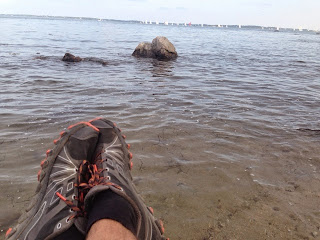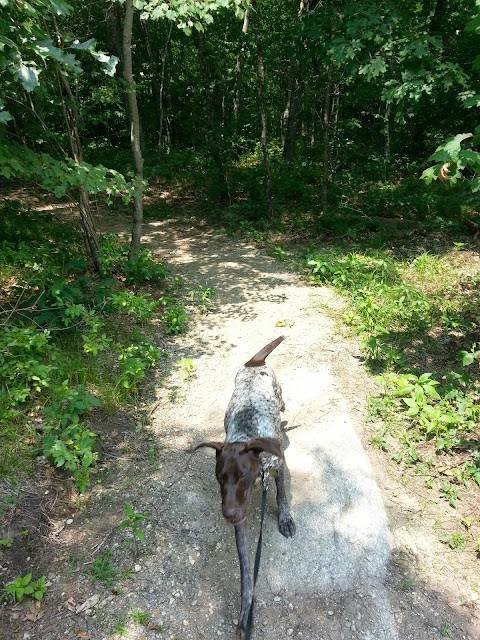I completed my first ever ultra pacing duties. It was exhilarating. The only person with a deeper high, would be my runner. Sean successfully completed his first 100 mile effort, breaking his target goal of 24 hours by nearly 90 minutes. Going through this has confirmed many of the pacing theories I had researched. I knew the value of a pacer, having only survived Zion 100 with a pacer and well prepared crew. I wanted to prove that same value to Sean. A good pacer can save a race and reduce the pain for the runner. Success brings great joy for both pacer and runner. Failure, while isn't considered an option, lingers in everybody's mind. In my young ultra career, I haven't experienced a DNF, and don't know what that translates to emotionally. Let's try and keep it that way.
 |
| Pretty House Aid Station (21m). Sean with Colleen |
Sean's crew was fabulous. They proved to be a valuable motivational tool late in the run. The crew, made up of his mom, three cousins (who flew in from California for this), and his girlfriend, were all novices. Not only with how to crew, but the ultra as a whole. They caught on quickly though. I helped guide them with initial instructions on to best support him, and sent them on their way to deal with it solo early in the race. After the start, I didn't see the crew until mile 70. At Camp 10 Bear (69.6mile) Aid Station, the crew showed up with smiles, and gave me a thumbs up stating they followed my directions and felt Sean was doing well. For those that have never crewed, the most basic task is to stay positive (smiles, encouragement) and do whatever the runner asks. This team had that task down pat. I asked the crew to be a little more proactive, and take the water/food bag (Nathan's, Camelback, etc) and water bottles from the Sean. Maintaining continuous dialogue with the him is required. Often, through the later stages of the race, a runner is mostly motivated to see their crew. They want to know how long till the crew, as opposed to the end of the race. Seeing familiar faces and hearing voices of friends and family is a significant motivator. Sean's crew flourished. They showed no signs fatigue, despite the nearly 20+ hours lack of rest. Given they only saw Sean for maybe a total of 20 minutes between start and finish, demonstrates their dedication and support.
A+ CREW!
Not only did the crew help Sean, but they helped me. As the crew could attest, I was extremely nervous about falling short for Sean. Yeah I knew I could run 30 miles. But my fear lingered about my ankle giving out, or that I just couldn't have the endurance to pull him through. I had coordinated a backup plan with one of the other Shenipsit Striders to come in should I tap out. Dave was such a trooper, staying with the crew all night just in case I bailed.
The first few miles after mile 70 is mostly uphill which gave us plenty of opportunity to walk and talk. Sean made it clear the downhills had done a number on his quads. This is nothing unusual, in fact this is quite common within the ultra marathon community. Sean had prepped for the downhills, but it was obvious not quite enough. We also worked out some logistics. Typically this is addressed before the race- but due to our familiarity with each other's personalities, we left it for discussion during the run. For a novice pacer I'd suggest at least discussing who should lead, does the runner want the pacer to engage in conversation, should the pacer continue to talk even if the runner is silent (think comforting background music). Upon meeting up with the runner, pacers need to do a systems check of the runner. What are the pain points? How are they mentally? Any symptoms of dehydration didn or hyponatremia? Sean was feeling good mentally. Physically his quads were fatigued, which he noted slowed his pace significantly over the last few miles before Camp 10 Bear. This became obvious to me as I watched his gait down hills, he was sitting back like a runner with shredded legs. I decided to try and mix things up. During a nice single track downhill section, I asked him to open up his stride, much like he did during our training runs together. I reinforced that this was not going to be permanent effort, but let's just try it a few times on a couple down hills. On the flats it was return to norm. Back to his version of the ultra shuffle. I did not want to push too long, this late in the race, and risk a complete meltdown with less than 30 miles to go. We continued to walk up hills, which took little bit of training for me. I tend to walk faster than Sean, and most runners in fact. So I slowed my stride down on the uphill, and continued to put the emphasis on him moving quickly with the downhills. For those that are not familiar with the Vermont 100, this course has a very large percentage of dirt road. This is extremely demoralising. It it is as if you are running on pavement for most of a hundred mile run. This is not a dig on the race, it is what the course presents to you as a challenge. During these sections the long dirt road running, I made no effort to push him. Whether it was flat, uphill, or even downhill.
Timing of pacer antics., motivational speeches, and/or general distractions is important as well. Surprising my runner with impromptu comments, questions, sounds, movement, etc were all done with the intention of diverting the mind's attention away from itself. On the lengthy dirt road, my job became one of distraction and encouragement. I never attempted to push the pace when we were off of single track trail. During one long section of road, Sean had taken a turn towards the mental abyss. I knew he was either there, or on his way to dungeons. I remember a juggling with the dilemma. Do I try and distract him now, or delay until he has hit the bottom of the pit? My fear was if he was on the downward spiral, anything I say or do would have no effect, as the downward momentum is in place already. I elected to wait for a lengthy period of silence. Then I made my move. I am throwing him the rope. After a few minutes, under a sliver of a quarter moon and our headlamps, I spread my arms out and performed a 'fly by' in front of him. Complete with sound effects. With a smile, and a bit of a chuckle, I received the response I was after. "Oh Steve, this is why I brought you along". Good. He grabbed the rope. We are working him out of the pit.
I've known Sean for nearly a year. We've run probably a dozen times, accumulating 40+ hours of trail running time. Through these long runs together, we've learned a lot about each other. I do know Sean isn't averse to having a conversation during a long run. Some runners prefer silence. Sean and I aren't that type. As his pacer, I needed to find the subject 'du jour' that will spark a two way conversation. If Sean is talking, he isn't thinking about the pain. So, throughout the early parts of the run, I'd throw out different topics to see what stuck. Eventually, I found the golden nugget. Anything trail running: Rob Krar's racing schedule, 2014 Western States 100, HardRock 100, etc. Throughout the run, when Sean appeared to need a distraction, I'd bring up a related topic. Most times he responded and we would chat for a mile or two. Sometimes I was met with utter silence. In those instances, he let me know to keep talking as he was listening. THAT....I....CAN...DO!
Sean hit his lowest point around mile 97. The 'ultra shuffle' was significantly slower than anything we had done previously. My casual walk was only slightly faster. He openly stated that his knee was bothering him, 'more than just soreness, it may be something bad'. Shortly there after, he complained of dizziness. DEAR GOD, DON'T DO THIS TO US NOW! At this point, any thought I had of a strong finish was quickly thrown overboard. This was the only time that I worried we wouldn't finish. 3 miles to go, we are in jeopardy. My ship was sinking, I needed to find a way to get him across the finish line at any cost. PERIOD. I encouraged him to walk more. The effort vs gain just wasn't there while he vainly attempted a 'run'. I was no longer trying to distract him. At this stage, I am seeking ways to drag his ass to the line.
Around mile 98 the course had been modified. We were warned during pre-race, to watch for the saw horse. The land owner had enough of whatever runners had done in years' past. Fortunately, the neighboring property was opened up to the runners. Unfortunately, the recently cut trail (maybe a month old?) hadn't had enough foot traffic to really make it a trail. Sure, it was cleared of trees, shrubs, and other general ground forestation, but the surface wasn't stable. Lots of undulations. This is where weak ankles meet there next rollover. Footing wasn't solid. To compound our problem, beyond the body beating, was one of the biggest ascents we had to deal with since mile 70. At 2AM, all that was visible beyond 10 feet, were the green glow sticks. Upon seeing each glow stick off in the distance rise higher than the previous, we realized the size of this next ascent was significant. It was a bit demoralizing. My heart sank even further as we hiked the ascent and I peaked behind us. I could see a pair of headlamps rapidly approaching us. While Sean wasn't concerned about competition with other runners, I wanted to catch every pair of withered legs ahead of us. This set of headlamps potentially represented only the second runner to pass us during my 30 mile pacing duties. Given Sean's condition, I succummbed to the notion that we lost a place. As we started to crest the lengthy hill, Sean said , "Let's go". Initially I thought it was the runner behind us, as they had closed to within 20 yards and I could hear the conversation clearly. It only took a moment to realize, IT WAS MY RUNNER. Maybe we have some juice left. We ran a short bit to an open field, which presented us with a very long and gradual descent. I tried a technique I used earlier to get him to move quickly on the downhills. "Open up the stride Sean, stop sitting". We were moving now, almost with a purpose. He had a second wind with maybe a mile and half to go. After turning out of the open field, we both looked back and saw four headlamps. SHIT, TWO RUNNERS! Most important to me however, was that Sean looked back. SEAN IS RACING! He let me lead, and I pushed. It is the one thing both of us agree that I bring to the table - I have the speed. Sean stuck. I pushed harder. Sean stuck. We ran up, down, flat - - nearly all out. I was talking the entire way. Trying to keep Sean in the zone "Focus on your breathing", "short easy steps on this up hill", "open up the stride here". We had another opportunity, with about 1/2 mile to go, to look back. The lights were gone. I expected Sean to ask to pull back on the pace and relax to the finish. However, the antelope wanted some more space from the lions, so we pushed all the way to the finish line at 2:37AM. Greeted by spectators, friends, and family. 100 miles. Under 24hrs. There, Sean got what he wanted most, a hug from Colleen. My task completed. Done. Hell of an experience.
 |
| 100 Miler Finisher's Buckle |
 |
| Sean with RD |
I AM DOING THIS AGAIN































